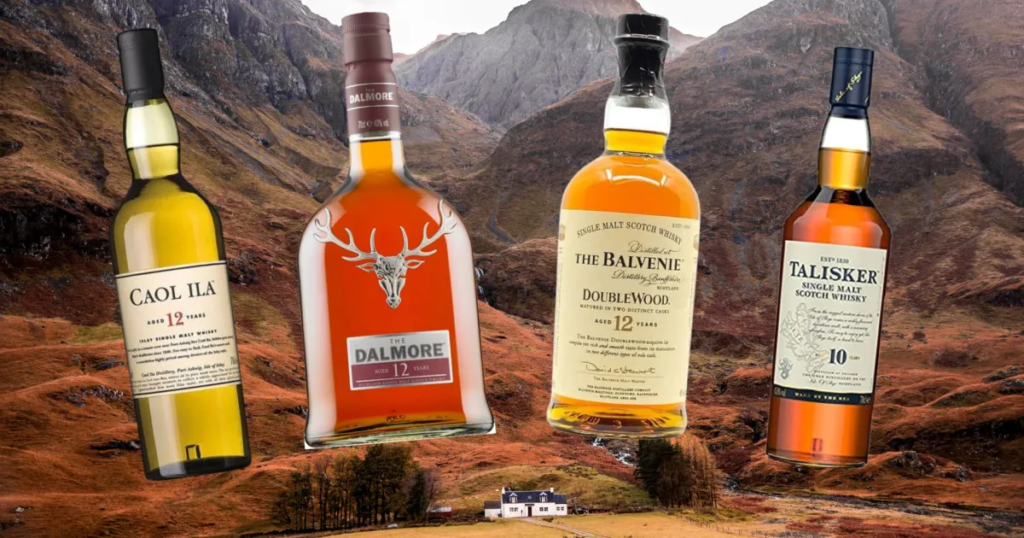
The Worldwide Popularity of Whiskey
Whiskey, a finely crafted spirit, enjoys widespread popularity globally. Its distinct flavor, derived from aged grains, attracts many connoisseurs. From Irish to Scotch and Bourbon, its variations cater to diverse palates, contributing to its universal appeal.
Differentiating Between Whiskey, Whisky, Bourbon, and Scotch
Whiskey and whisky are the same spirit, differentiated only by regional spelling. Whiskey (with an ‘e’) is generally used in Irish and American products, while whisky denotes Scotch selections. Bourbon, a type of whiskey, must be made in America from 51% corn, while scotch is barley-based whisky from Scotland.
Understanding Whiskey
Types of Whiskey
Whiskey types vary based on region, method, and composition. The main types include Scotch, Irish, American, and Canadian whiskey. These further branch into subtypes like Bourbon, Rye, Single Malt, and Blended whiskey. Each type has unique characteristics and flavor profiles.
Key Elements in Whiskey Production
Whiskey production involves key elements such as sourcing quality grains, malting, mashing, fermentation, distillation, aging, and bottling. Oak barrels’ aging adds to the distinct flavor and color of the final product.
Criteria for Judging a Fine Whiskey
Criteria for judging a fine whiskey include its color, aroma, taste, and finish. Quality whiskey exhibits clarity and richness in color, complex aroma, a well-balanced flavor profile, and a long, satisfying finish.
Whiskey Production Process
Raw Materials Used in Whiskey Fermentation
Whiskey fermentation utilizes raw materials like malted barley, water, and yeast. The malted barley, when heated, produces enzymes which convert the barley’s starches into fermentable sugars, which yeast then ferments into alcohol.
Distillation Process
Distillation is a process used to separate mixtures based on differences in the volatility of components. It involves heating a liquid to create vapor that is then condensed into a liquid, separating the original elements.
Maturation and Aging
Maturation and aging are natural biological processes that every individual undergoes. Maturation represents growth and development towards maturity, while aging involves physical and functional decline over time. Both impact an individual’s health and quality of life.
Comprehensive Whiskey Tasting Guide
Preparing a WhiskeyTasting
A whiskey tasting requires careful preparation. Ensure a variety of whiskey options, including diverse blends and ages. Provide palate cleansers such as water or light snacks. Finally, educate participants on tasting techniques and the history of each selection.
Understanding the Whiskey-Tasting Process
Understanding the whiskey-tasting process involves assessing aspects such as color, aroma, taste, and finish. This elaborate process aims to appreciate the complexity and layers of flavors in the whiskey, enhancing the overall drinking experience.
The Importance of Color, Texture, and Taste Notes
The integration of color, texture, and taste notes is crucial in enhancing sensory experiences, particularly in food and design. These elements stimulate visual appeal, evoke emotions, influence perception and significantly dictate overall satisfaction and appreciation.
Whiskey Recommendations for Novices
Overview of Beginner-Friendly Whiskeys
Beginner-friendly whiskeys offer smooth, subtle flavors ideal for those new to this sophisticated spirit. They include well-known brands like Jameson, Crown Royal, and Monkey Shoulder, which are perfect for those learning to appreciate whiskey.
Factors to Consider when Choosing a Whiskey for Beginners
Choosing a whiskey for beginners includes considering factors such as flavor intensity, alcohol strength, type of whiskey, like bourbon, rye, or scotch, and price. Opt for smoother, sweeter profiles to ease into whiskey-tasting.
Tips on Enjoying Whiskey as a Novice
As a whiskey beginner, start with lighter, smoother blends before exploring heavier ones. Use a tulip-shaped glass, enjoy it neat or on rocks depending on preferences. Remember, savor each sip, relishing the varied flavor notes.
Exploring Whiskey Cocktails
Whiskey Cocktails
Whiskey is a globally renowned distilled alcoholic beverage that has been savored for centuries. Originating from the Gaelic word “uisce beatha,” meaning “water of life,” whiskey is typically made from fermented grain mash, which can include barley, corn, rye, and wheat. Its taste and character can significantly vary, depending on factors such as the type of grain used, the distillation process, the aging period, and the type of barrels it is aged. Noted for its robust, nuanced flavors and its rich history, whiskey is not just a drink but an embodiment of craftsmanship, tradition, and cultural heritage.
Guide to Making Homemade Whiskey Cocktails
Delve into the fun world of homemade whiskey cocktails with this guide. It helps you master the art of mixing varying whiskey blends, fruits, herbs, and spices to create your own delightful, personalized beverages right at home.
Pairing Cocktails with Meals
Pairing cocktails with meals can significantly enhance your dining experience. The right cocktail can complement food flavors, balance richness, and encourage delightful gustatory discoveries, leading to satisfying food and drink harmony.
Responsible Drinking
Health Benefits and Risks of Whiskey Consumption
Whiskey, consumed in moderation, may benefit heart health, improve digestion, and reduce stroke risk. However, excessive consumption increases risks of liver disease, and addiction, and could potentially impair mental and physical health.
Importance of Moderation and Responsible Consumption
Moderation and responsible consumption are crucial for sustainable living. They promote health, avoid wastage, and prevent over-exploitation of resources, contributing to environmental preservation and economic stability.
